Hannah Braime's Blog, page 13
March 31, 2017
Goodbye, March
Let’s say goodbye to the month that has been and get ready for the next with a roundup of 10 questions, recommended reading, and fun/useful links.
 A huge thank you to all my Patreon supporters, including new patrons Antonia and Daniel. I appreciate your continued support! If you enjoy Becoming Who You Are and would like to help support the site and the work I do here, I am offering special perks and rewards for patrons so please check out my Patreon page.
A huge thank you to all my Patreon supporters, including new patrons Antonia and Daniel. I appreciate your continued support! If you enjoy Becoming Who You Are and would like to help support the site and the work I do here, I am offering special perks and rewards for patrons so please check out my Patreon page.
Hello friends, how has your March been? Mine was an odd mixture: on the one hand, this month felt like it draggggged on. On the other hand, I look back and wonder where all that dragging time went and what I have to show for it. This week, writing an upcoming blog post about the tension between self-acceptance and self-improvement, I was reminded this is part of life’s cyclical nature. February was an “on” time for me. March has been slower. And that’s how it goes: in work, in life, in all important things. We have times of focus, progress, development, and activity, and times of rest, research, rejuvenation and passivity. But now, as I write this, the days are getting longer, I’m feeling energised by a few days of beautiful sunshine, and I’m ready for April! Let’s say farewell to this month with a quick review:
10 Questions for you
March
1. What went well this month?
2. What was the highlight of this month?
3. And the lowlight?
4. Who was your favourite person to connect with this month?
5. What one lesson are you taking forward from this month?
April
1. If you could create one thing in April, what would it be?
2. What are you committed to not doing this month?
3. Imagine you are sitting here at the end of April and thinking about the month gone by. How will you know this has been a good month?
4. What area of your life would you most like to nurture during April?
5. What would you like to read/watch/listen to this month?
Articles of the Month
What to do when your need to please is ruining your life
Naive vulnerability vs. awake vulnerability
These are the top 37 things you’ll regret when you’re old
How friendships change over time in adulthood
Flaking out is not self-care
25 ways to simplify your life in 10 minutes or less
The opposite of addiction is connection
Quote of the Month
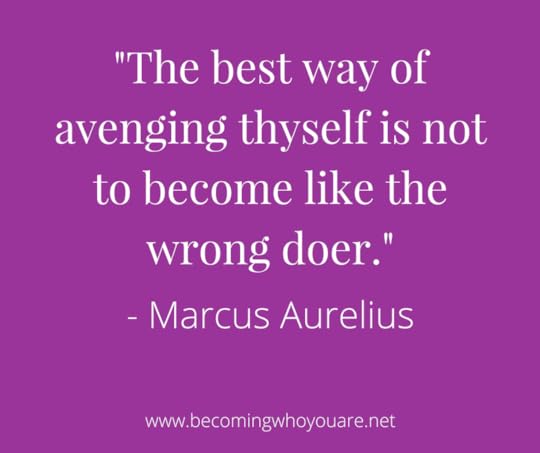
“The best way of avenging thyself is not to become like the wrongdoer.” – Marcus Aurelius, Meditations
Book of the Month
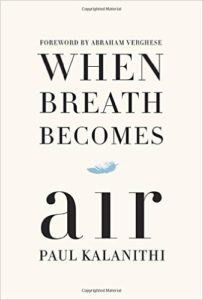 After hearing this book recommended more times than I can count, I finally got around to reading When Breath Becomes Air by Paul Kalanithi this month. Whew. It’s is a strange mixture of tough (because death) and life-affirming (for the same reason). If you’re not familiar with the backstory, Paul was a brilliant neurosurgeon who was diagnosed with terminal cancer at the age of 38. His book is part memoir, part reflections on death and uncertainty. It’s a deeply moving book that feels unfinished, because it is; Paul died before he could complete it. Although his writing is beautiful, his wife’s epilogue and description of his death was, for me, the most moving part. This isn’t light reading but, given death is a certainty at one point or another for us all, it’s a moving reminder to make the most of the time we do have because we don’t know how long that might be.
After hearing this book recommended more times than I can count, I finally got around to reading When Breath Becomes Air by Paul Kalanithi this month. Whew. It’s is a strange mixture of tough (because death) and life-affirming (for the same reason). If you’re not familiar with the backstory, Paul was a brilliant neurosurgeon who was diagnosed with terminal cancer at the age of 38. His book is part memoir, part reflections on death and uncertainty. It’s a deeply moving book that feels unfinished, because it is; Paul died before he could complete it. Although his writing is beautiful, his wife’s epilogue and description of his death was, for me, the most moving part. This isn’t light reading but, given death is a certainty at one point or another for us all, it’s a moving reminder to make the most of the time we do have because we don’t know how long that might be.
Useful Tool of the Month
 What could you do with 100 days of making? Starting on April 4th and running up to and including July 12th. #The100DayProject is, as the name suggests, a commitment to making something for 100 days. This might be writing, singing in the shower, cooking, meeting new people or taking photos. Personally, I’m aiming for 100 days of hand lettering. I’ve been learning to letter for the last few months and I’m hoping this challenge will give me an opportunity to practice, practice, practice. What I love about the philosophy behind this challenge is it’s not about what you create by the end of the 100 days, rather the goal is to show up each day (or as often as you can). This is what makes a difference to anything we’re learning or doing in life and any area in which we’re trying to grow, so I hope you’ll join me in the challenge!
What could you do with 100 days of making? Starting on April 4th and running up to and including July 12th. #The100DayProject is, as the name suggests, a commitment to making something for 100 days. This might be writing, singing in the shower, cooking, meeting new people or taking photos. Personally, I’m aiming for 100 days of hand lettering. I’ve been learning to letter for the last few months and I’m hoping this challenge will give me an opportunity to practice, practice, practice. What I love about the philosophy behind this challenge is it’s not about what you create by the end of the 100 days, rather the goal is to show up each day (or as often as you can). This is what makes a difference to anything we’re learning or doing in life and any area in which we’re trying to grow, so I hope you’ll join me in the challenge!
In case you missed it
5 ways to inspire your journaling practice
No isn’t always a complete sentence
5 ways to improve your self-esteem in recovery
The Johari Window: A useful framework for personal growth
How to accept compliments with grace and gratitude
Image: Anthony Delanoix
The post Goodbye, March appeared first on Becoming Who You Are.









March 27, 2017
How to Accept Compliments with Grace and Gratitude
Do you find it challenging to accept compliments? A few weeks ago, I was talking to my friend Stephanie about my new book (which is about self-kindness. You will see the irony here in juuust a second). I’d reached the point of “done is better than perfect,” and was telling her that I planned to release it this year, even though I wasn’t totally happy with it. Stephanie had just finished narrating the audiobook of From Coping to Thriving (and did an amazing job), and she said “I remember you saying that about FCTT and I thought it was great!”
A graceful response would have been “Thanks!” or “That means a lot to hear,” or something along those lines. Instead, faster than you can say “pity party” I responded “Yeah, I feel that way about all my books,” and the conversation moved on.
Afterwards, I realised with a tinge of guilt that my response was dismissive bordering on rude. Someone had shared genuinely positive feedback with me and, because it didn’t sit with my own (unrealistic, perfection-driven) story, I a) hadn’t acknowledged it myself, and b) hadn’t shown my appreciation and gratitude to a dear friend.
This isn’t an isolated incident. When I’m not being mindful of my responses, my knee-jerk reactions to compliments is to downplay my effort or the result. Not only does this distract from the compliment, but it’s a bit of a slap in the face for the person giving it too. When I respond in this way, I’m essentially saying “Thanks. Here’s why you’re wrong.”
I know I’m not alone in finding it hard to accept compliments with gratitude and grace. And I know there isn’t one simple reason for this. For me, it stems from the part of my internal dialogue that tells me I’m not enough, the fact that I was taught that acknowledging things I’m good at and have done well is boastful (and no one likes a boastful person), and not wanting to raise people’s expectations of me in case I disappoint them in the future. It’s a self-protective mechanism that—like most self-protective mechanisms—backfires spectacularly and puts a damper on other people’s generosity and vulnerability.
So, like most of the posts here on Becoming Who You Are, this post is as much for myself as it is for you. I found it useful to think through how I want to respond to positive feedback and the different ways I could do so. I hope it’s helpful for you too.
Stop, pause and take a breath
We always have a choice how we respond to the things that people say to us and compliments are no different. The situation I described above is a classic example of reacting rather than responding, so one way I’ve made it easier to accept compliments with grace and gratitude is to stop and pause.
I’ve found it helpful to practice pausing and taking a breath before I say anything in response. The pause might be mere seconds but it helps reign in the desire to downplay or negate positive feedback and helps me remember how I’d like to respond.
Pausing also gives me a chance to reflect on how I feel in response to what the other person is saying. Not only does this help me enjoy the warm fuzzies that come from genuine positive feedback more but it also helps me be more specific in how I respond (see below). Saying to someone “Thanks, that makes my day!” because it truly does creates a positive feedback loop. When we offer someone positive feedback and can see it is gratefully received, we’re more likely to do so again in the future.
Say thank you, then nothing.
In The Year of Yes, Shonda Rhimes writes about her own struggle to accept compliments and positive feedback. She also shares her approach to dealing with these struggles: ”Say thank you, smile and shut up.”
This is something I’ve been practising and it can feel super uncomfortable to accept compliments and leave it at that. However, I like this approach because it’s simple and it helps us avoid the urge to immediately follow up with self-deprecation or minimisation. Similar to the pause I mentioned above, shutting up also gives me the chance to be mindful of what I say next.
Share how it feels to hear the feedback
Although we often talk about how difficult and vulnerable it can feel to share issues, requests and so-called negative feelings, it can also feel vulnerable to share our joy in the form of positive feedback and compliments. So, if someone else is willing to be vulnerable with us in that way, one way we can show them the same in return is by reflecting how it feels to hear their feedback.
This could be as simple as “Thank you, that means a lot,” or “thank you so much, I appreciate you taking the time to share that.” As long as we stick to expressing our gratitude (rather than using it as a springboard to leap back into self-deprecation) and mean what we say, there is no wrong way to respond.
Acknowledge your hard work
We tend to have a rather messed up view of success, especially thanks to our ability to filter and curate what other people see of us online. It can often seem like people become successful (however you define that) effortlessly, or have lives that are unrelatably perfect compared to ours. In reality, success at anything takes hard work, grit and perseverance.
That’s why I love this response to positive feedback and compliments from Sarah Von Bargen: “Thank you, I worked hard at it.”
Not only is this usually true (and we should own it!), but it also reinforces a much healthier idea of success that is based on a growth mindset rather than a “you either have it or you don’t” attitude.
Bask in the glow (and take note for future reference)
When I worked with coaching clients, one of the exercises I’d ask them to do was to approach three people in their lives and ask these people to tell them what they thought their strengths were. This exercise did not meet with much love (because cringe) but I would set it because other people can usually see things about us that we ignore or can’t see ourselves.
Noticing what other people compliment us on serves a similar purpose. It can clue us in to what people see in us that we might discount because it’s a natural strength (and therefore we assume everyone is like or can do that) or we tend to gloss over because it falls outside of our personal stories about ourselves.
What if, instead of assuming they were wrong or somehow mistaken, we assumed they were right? Many of us (myself included) are quick enough to internalise negative feedback and criticism, so how about internalising the good stuff too?
Let’s start today.
Do you have any suggestions about how to accept compliments with grace and gratitude? Leave a comment and share your thoughts.
 If you enjoyed this post and would like to support Becoming Who You Are, check out our Patreon page. Patreon is a simple way for you to contribute to this site and support the free content, tools and resources here. As a thank you for your support, you can get special Patron-only perks and rewards; find out more here.
If you enjoyed this post and would like to support Becoming Who You Are, check out our Patreon page. Patreon is a simple way for you to contribute to this site and support the free content, tools and resources here. As a thank you for your support, you can get special Patron-only perks and rewards; find out more here.
Image: Ben White
The post How to Accept Compliments with Grace and Gratitude appeared first on Becoming Who You Are.









March 20, 2017
The Johari Window: A Useful Framework for Personal Growth
When I start talking to people about personal growth, I’m often aware of how nebulous that phrase sounds. What is personal growth? What does that actually mean? And how do we know when we’re doing it? I don’t like doing things for the sake of them so I’ve tried to get as clear as possible on what personal growth looks like and how I know when I’m “doing” it. In this post, I want to share a framework I’ve found helpful for this called The Johari Window. I hope it’s helpful for you too!
The Johari Window sounds exotic, but the name is a portmanteau of its creators: Joseph Luft and Harrington Ingham. They created this framework in the 1950s and developed an exercise designed to deepen our awareness of the parts of ourselves we show, those we hide, and how we perceive ourselves compared to how others perceive us.
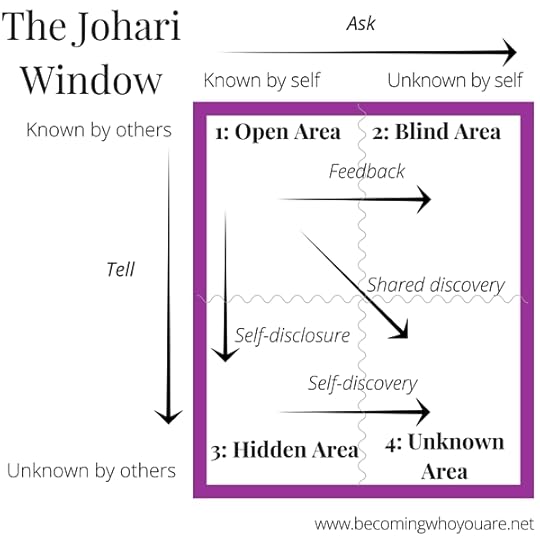
In the traditional exercises, subjects are given a list of 57 adjectives to choose from to describe themselves. Then, their peers are given the same list of adjectives and asked to choose those that best describe the subject:
Adjectives selected by both parties go in the Open/Arena box.
Adjectives selected just by the subject go in the Hidden/Facade box.
Adjectives selected by peers and not by subjects go in the “Blind” box.
Any remaining adjectives not chosen by either parts go into the “Unknown” box.
Exploring your Johari Window
1. Write down the aspects of yourself you believe are in the open area. Include adjectives you’d use to describe yourself, your values, passions, what’s important to you and anything else that feels relevant.
2. Ask 5 people who know you well to share their own list about you. Questions you can use include:
What do you value about our relationship?
What do you think my top 3 qualities are?
What would you say I’m passionate about?
3. Compare the two lists. Write the adjectives other people used to describe you that you mentioned too in the open area. Write the adjectives others used to describe you that you didn’t mention yourself in the blind spot area. Finally, write everything you wrote about yourself that others didn’t mention in the “hidden” quadrant.
What do you notice about the distribution of your window? Is there anything in the hidden or blind spot window that is a surprise? How do you think you can embrace or show more of these aspects of yourself?
We can also use this tool for our personal reference, to get a sense of what personal growth is all about. Part of becoming who we are is expanding the open area in the direction of the arrows inside the box. It’s also about diminishing the blind area and unknown area through feedback and self-discovery. At the same time, reducing the size of our hidden area through unpacking feelings and beliefs around our shadow side and becoming more comfortable with self-disclosure also helps us nurture deeper intimacy and closeness within our personal relationships.
Have you tried using the Johari Window? What did you learn? Leave a comment and share your thoughts!
Further reading: Christmas party games for people who love self-discovery & how to master the ABCDs of happiness
 If you enjoyed this post and would like to support Becoming Who You Are, check out our Patreon page. Patreon is a simple way for you to contribute to this site and support the free content, tools and resources here. As a thank you for your support, you can get special Patron-only perks and rewards; find out more here.
If you enjoyed this post and would like to support Becoming Who You Are, check out our Patreon page. Patreon is a simple way for you to contribute to this site and support the free content, tools and resources here. As a thank you for your support, you can get special Patron-only perks and rewards; find out more here.
The post The Johari Window: A Useful Framework for Personal Growth appeared first on Becoming Who You Are.









March 13, 2017
5 Ways to Improve Your Self-Esteem in Recovery
This is a guest post by Andy.
I was born in Medellin, Colombia. Life was dangerous and dodging bullets was a skill you couldn’t live without. Literally. Back in the ‘80s, Medellin was pretty much the most dangerous city in the world. Luckily, my parents took my brother and I out of there when we were still very young. Life in Southern California was a dream. We had a great life, a great childhood, and I was the happiest I had ever been. But drugs and alcohol found their way into my life and it was all ruined.
I experienced my first drunken episode at the age of 9, which started my trip down the rabbit hole. A decade later I was dependent on a myriad of drugs and alcohol, and at 23, I ended up in jail for 2 years. Since then I’ve relapsed, attempted suicide, and gotten back into recovery. Now I’m over 8 years sober.
In these 8 years I’ve learned that one of the most important tools in recovery is a healthy level of self esteem. Improving my self esteem, apart from getting sober, is just about the toughest thing I’ve ever had to do in my life.The good news is that once you’ve gotten around to seeing yourself in a more forgiving, positive light, everything else gets much easier.
1. If it doesn’t serve you, get rid of it
First of all, recovery has to be your primary focus. It comes before anything else. So if something is going to hinder your sobriety, you don’t need it in your life. This applies to people, places, and things.
As someone who has lived a vast majority of their life as an addict, I know that one of the hardest parts about recovery is leaving the people that influenced or fueled your addiction behind. But you have to do it. Say no when they ask you to come hang out, when they offer you that drink. Just say no. By saying no you are reclaiming your power over yourself. You are reclaiming control over your life. Those people may get hurt, or upset, or call you cold, but that’s not your problem. Your focus is you, and your recovery.
2. Baby Steps Pace yourself.
All or nothing is not the way to go when it comes to early recovery. You should definitely remove anything that could possibly tempt you or bring you down from your life, but you shouldn’t feel like you have to knock every single thing off your checklist on the first day.
Set small, reasonable goals. Set daily goals, weekly goals, monthly goals, and so on. But don’t beat yourself down if you’re unable to complete every single one. Doing that will only undo whatever progress you’ve made in improving your self esteem.
Recovery is a process, and any progress you make is a step closer to your ultimate goal of living a clean, healthy, and happy life. You should feel good about that.
3. Celebrate your journey, but don’t dwell on the past
Do remember how far you’ve come. Take pride in the fact that not only have you acknowledged the fact that you have a problem, and asked for help, you are actively pursuing recovery. That is incredible. No matter where you started, you are here now.
Do not get stuck on mistakes that were made or any regrets you may have. You are human. Your past doesn’t define you, mistakes don’t define you. You are allowed to make mistakes. It is okay. To err is human. What is important is that you learn from mistakes and move forward.
Also, forgive yourself. This is key. You simply cannot successfully recover from alcoholism and/or drug addiction while carrying guilt. Forgive your mistakes, your past choices, your past lifestyle. Let it go. Do not allow it to weigh you down. Do celebrate that you’ve made it this far.
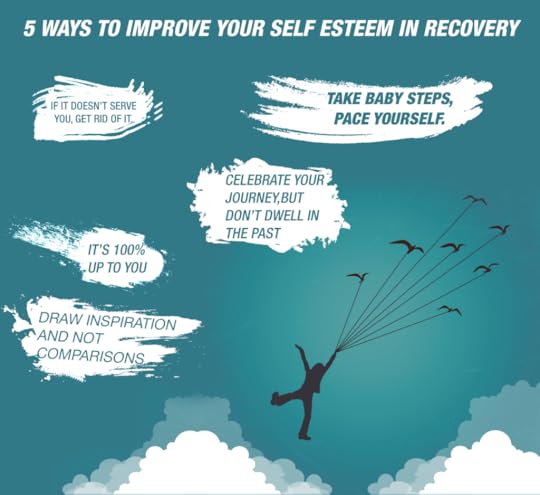
4. Draw inspiration, not comparisons
It’s impossible not to notice other people and their journeys. The key to not letting it bring you down is in your perspective.
Many times, sitting in AA meetings or NA meetings I felt myself belittling myself because someone else was doing better than me, or started recovery much younger than I did, or was sober longer than I was. This was defeating the purpose of the meetings.
So then I began to draw inspiration from others. Instead of comparing myself to other people, I saw their achievements and used them to encourage me. Instead of feeling threatened by other people and their success, I became even more enthusiastic about my own recovery.
Rather than feeling like I had to compete with the other people there, I began to understand that everyone has their own journey, their own struggles, just like I had my own.
5. It’s Up To You
Self esteem is not something that someone else can give you. It is something that you have to build for yourself. At the end of the day, if you don’t feel good about yourself, it does not matter how many people are there encouraging you, giving you compliments, and trying to make you feel better.
I know, it is hard to look in the mirror and feel proud of your reflection after everything that you’ve been through, but you’re here now. You’re better now. You are working to be a healthier, cleaner, better version of yourself and that is something to be proud of.
There are a few things you can do to drive that thought home: compliment yourself, make a pro list, and treat yourself.
This is not a joke. It may seem silly, and it’s probably going to be harder than you think, but compliment yourself. Start small, look in the mirror and tell yourself how great you look. Did you see a drink and decide against it? You’re doing great. For some reason it is much easier for us to compliment other people than it is to compliment ourselves. Change that.
Physically write down a list of positive qualities, or things that you’re proud of. It may start out a rather small list, but keep adding to it as more things occur to you. Carry this list with you at all times so that you can always update the list and remind yourself of how great you are.
It’s great to know that you are making progress, but it’s even better to treat yourself for your little victories. Go to the movies, go to a restaurant, go bowling with friends, go paint-balling, do anything that will make you happy, something you wouldn’t regularly do.
Always Remember
Recovery is a roller coaster. There will be ups and there will be downs. There will be days when you wake up feeling a little worse for wear but going to bed feeling much better, and vice versa. You will probably have whole days that just don’t go your way. Just take life one day at a time. Don’t be discouraged. This is normal. You are doing great. You are perfect.
About Andy
 Hi, I am Andy! I was born in Bogota, Colombia but raised in Los Angeles, California. I am 8 years sober (almost 9!). I spend my time helping others with their recovery and growing my online business. Read more of my writing at Northpoint Recovery.
Hi, I am Andy! I was born in Bogota, Colombia but raised in Los Angeles, California. I am 8 years sober (almost 9!). I spend my time helping others with their recovery and growing my online business. Read more of my writing at Northpoint Recovery.
Image: Alex Blajan
 If you enjoyed this post and would like to support Becoming Who You Are, check out our Patreon page. Patreon is a simple way for you to contribute to this site and support the free content, tools and resources here. As a thank you for your support, you can get special Patron-only perks and rewards; find out more here.
If you enjoyed this post and would like to support Becoming Who You Are, check out our Patreon page. Patreon is a simple way for you to contribute to this site and support the free content, tools and resources here. As a thank you for your support, you can get special Patron-only perks and rewards; find out more here.
The post 5 Ways to Improve Your Self-Esteem in Recovery appeared first on Becoming Who You Are.









March 5, 2017
No Isn’t Always a Complete Sentence—and This Is Why
The personal growth world is full of pithy one-liners that appear to summarise the answer to a universal struggle in a single sentence. One of these is “No is a complete sentence.”
The problem with these pithy statements is that life is usually far more nuanced than they make out. Saying no is no exception. This is part of a wider topic: boundaries. As with many personal growth topics, when we start exploring how we approach boundaries in our lives, we can end up in what Amy Smith (who I interviewed in #96 of the BWYA podcast) calls “self-help gone bad.” We discover we’ve been living at one extreme end of the spectrum (for example, being other people’s personal doormat) and react to this by doing a complete 180 to the other extreme, becoming unnecessarily rude or over-demonstrative when asserting or enforcing our boundaries. This is where conventional wisdom like “No is a complete sentence” is only half the story.
It’s true we owe no one an explanation; responding with a no is our prerogative, and no one has a right to demand a reason or change of heart. Even though it’s not owed, however, in some contexts it’s in the best interests of the relationship to share more. In my experience, the “No is a complete sentence” statement can become something we hide behind when we’re not comfortable owning our own needs and preferences. In this situation, it’s easier to avoid feeling discomfort around declining by shutting down the conversation with a single defining “No” than it is to be vulnerable and share a little more of ourselves in the process.
The way I think about “no” is that it’s a spectrum and it’s a personal spectrum. The boundaries of part of the spectrum will be different for each of us, but I’ve found it useful to be aware of the varying degrees of “no” and think about which kind of response feels right for me.
Introducing: The spectrum of “no”
NRN (no response needed): In some situations, the best kind of no is no response at all. Everyone’s tolerance for this is different. I apply this to things like unreasonable requests, spammy communication, and nasty emails, as well as any kind of harassment and inappropriate comments. Responding to these things is a waste of my time and only serves to prolong a fruitless and pointless interaction.
No + no explanation: This is where “no is a complete sentence” fits right in. This might apply to requests from someone we don’t know or any situation where we’re not invested in our relationship with the person making the request. Even in this context, a no doesn’t have to be rude. It can be a “no” with a smile and still be a firm boundary.
No + generalised explanation: This might look like “it’s not a good fit,” “I’m not looking to take on any more commitments right now”, etc. I use this kind of no when I appreciate the person thinking of me but can’t (or don’t want to) honour their request. It’s a polite way of saying “Thanks but no thanks!” in a way that leaves the door open for further communication, connection and opportunities in the future.
No + personalised explanation: This is the no I reserve for relationships I’m invested in: my husband, my friends, and people I know, like and respect. This kind of no requires a little more vulnerability. It involves us stepping out from the blanket statement of “no is a complete sentence” and getting comfortable owning our needs and preferences. Offering this kind of no is not the same as making excuses or justifications. Instead, it’s about using the experience of saying “no” as an opportunity for connection.
The way I think about the varying degrees of no is this:
An explanation isn’t owed, but sometimes it is earned. When we apply the “No is a complete sentence” rule across the entire spectrum, we end up putting ourselves into needlessly confrontational situations (where no response would be better) and, at the other end of the scale, potentially harming relationships in which the other person has earned more explanation.
If my husband says “Hey, do you want to meet up with this group of friends tonight?” and at the end of a busy week it’s the last thing my introvert heart feels like doing, I could respond with “No.” But in that context, a “no” without explanation is more likely to build barriers than foster connection. If, however, I explain my reasons, clarify I want him to meet his needs (he is an extrovert) and offer alternative suggestions or a compromise that’s win-win for both of us, I’m showing him I understand him, I’m giving him a chance to understand me, and I’m attempting to work with him rather than shutting the conversation down.
Do I have to?
No.
But it makes for a healthier, happier and more fulfilling relationship.
What do you think about this idea of “The spectrum of No?” Leave a comment and share your thoughts.
Further reading: You can do anything but not everything & 7 must-read books that will help you better your relationships
 If you enjoyed this post and would like to support Becoming Who You Are, check out our Patreon page. Patreon is a simple way for you to contribute to this site and support the free content, tools and resources here. As a thank you for your support, you can get special Patron-only perks and rewards; find out more here.
If you enjoyed this post and would like to support Becoming Who You Are, check out our Patreon page. Patreon is a simple way for you to contribute to this site and support the free content, tools and resources here. As a thank you for your support, you can get special Patron-only perks and rewards; find out more here.
The post No Isn’t Always a Complete Sentence—and This Is Why appeared first on Becoming Who You Are.









March 1, 2017
#108: 5 Ways to Inspire Your Journaling Practice
If you’ve been around Becoming Who You Are for a while, you’ll probably know that I’m an e-nor-mous fan of journaling. Having spent many an hour writing, typing, reading, and reflecting, I also know that sometimes a regular journaling practice can start to feel a little stale. And when activities start to feel stale, we’re less likely to maintain them.
So, if you’d like to start, restart, or add a little more vim to your journaling practice this episode is for you. I’m sharing a few suggestions I’ve found useful for inspiring my regular journaling practice.
Useful Links
The Ultimate Guide to Journaling
The Artist’s Way by Julia Cameron
750words.com
Headspace meditation app
Meditation Oasis podcast
Say Hello
Hannah
Facebook: facebook.com/becomingwhoyouare
Pinterest:
pinterest.com/hannahbraime
Website: becomingwhoyouare.net
Get a Free Audiobook from Audible
This podcast is brought to you by Audible.com. If you enjoy Becoming Who You Are, you can support the show by registering for a free 30-day trial using the link below. As part of your trial, you’ll get a free audiobook and can cancel any time.
Subscribe to the Podcast
Intro and outro: Stephanie Murphy
 If you enjoyed this post and would like to support Becoming Who You Are, check out our Patreon page. Patreon is a simple way for you to contribute to this site and support the free content, tools and resources here. As a thank you for your support, you can get special Patron-only perks and rewards; find out more here.
If you enjoyed this post and would like to support Becoming Who You Are, check out our Patreon page. Patreon is a simple way for you to contribute to this site and support the free content, tools and resources here. As a thank you for your support, you can get special Patron-only perks and rewards; find out more here.
Image: Bino Storyteller
The post #108: 5 Ways to Inspire Your Journaling Practice appeared first on Becoming Who You Are.










February 27, 2017
Goodbye February
Let’s say goodbye to the month that has been and get ready for the next with a roundup of 10 questions, recommended reading, and fun/useful links.
 A huge thank you to all the new patrons who have pledged their support this month: Elizabeth, Thomas, Stephanie, Jake, Lorraine, Katie, Jacqui, Free Press Publications and Alton. I appreciate your continued support! If you enjoy Becoming Who You Are and would like to help support the site and the work I do here, I am offering special perks and rewards for patrons so please check out my Patreon page.
A huge thank you to all the new patrons who have pledged their support this month: Elizabeth, Thomas, Stephanie, Jake, Lorraine, Katie, Jacqui, Free Press Publications and Alton. I appreciate your continued support! If you enjoy Becoming Who You Are and would like to help support the site and the work I do here, I am offering special perks and rewards for patrons so please check out my Patreon page.
Although it’s the shortest month of the year, February has felt jam-packed on this end! As well as launching the Patreon for Becoming Who You Are, I did some travelling with my husband and kiddo and made slow but steady progress with a few other projects I’m working on right now. Balancing baby and work isn’t easy (I basically have 2 hours a day to do most things that require two hands) but I’m re-learning the importance of going with the flow, setting realistic expectations for myself, and focusing on the things that are truly important. There are some lessons in life I need to revisit on a regular basis, and these are three of them!
I hope you have had a good month, let’s get started with a quick review.
10 Questions for you
February:
1. What went well this month?
2.What lessons arrived with this month?
3. What would you do differently if you could have a February do-over
4. What were your predominant feelings this month?
5. What did you create this month?
March:
6. What is the one thing that, if you started doing it in March, would have the biggest positive impact on your life?
7. What is the one thing that, if you stopped doing it in March, would have the biggest positive impact on your life?
8. What are you committed to creating in March?
9. What are you looking forward to in March?
10. What would make March awesome this year?
Articles of the month
Conditions of enoughness
Embrace authenticity: how to break free from the tyranny of positivity
If you’ve ever been told you’re too much
29 pieces of life-changing advice I collected by my 29th birthday
Why the secret of a happy, successful marriage is treating it like a bank account
A conversation with Harriet Lerner about apologising
Doing the work is enough: stop letting others dictate your worth
The technique that helps me make decisions under pressure
How to feel all the feelings & still kick ass
6 toxic relationship habits most people think are normal
Quote of the Month
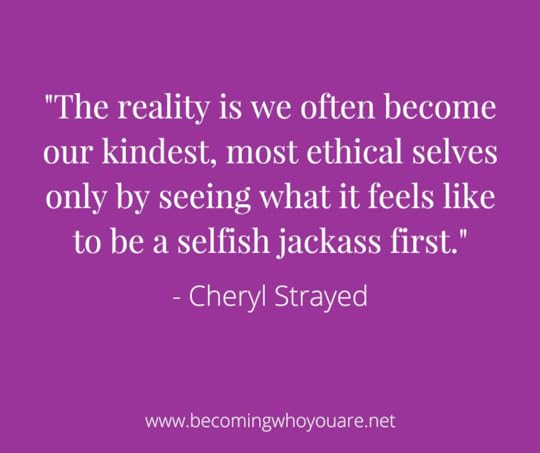
This quote (from Tiny Beautiful Things, more on that below) made me both laugh and shake my head with painful recognition. I love it because it’s not only true but also sheds a new, softer light on those moments from our past we don’t feel so proud of.
Book of the Month
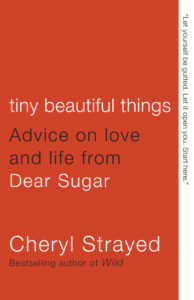 This month, I finally got around to reading Tiny Beautiful Things: Advice on Life and Love from Someone Who’s Been There by Cheryl Strayed. The book is a collection of letters from her advice column for The Rumpus, with a wide range of subjects including ambivalence around ending relationships, suicidality, writing, bereavement and more.
This month, I finally got around to reading Tiny Beautiful Things: Advice on Life and Love from Someone Who’s Been There by Cheryl Strayed. The book is a collection of letters from her advice column for The Rumpus, with a wide range of subjects including ambivalence around ending relationships, suicidality, writing, bereavement and more.
There are several things I loved about this book: first of all, her responses are so good. Like, “How is she not a therapist?!” good. She has a great way of taking even the most tangled, intractable-seeming situations and breaking them down into facts, principles and potential outcomes. Even though I couldn’t relate directly to many of the issues people were writing to her about, I felt there was much I learned from reading what she had to say about them. She usually includes stories from her own experience to illustrate her points. More than anything, each answer is beautifully written, deeply compassionate and startlingly frank.
Useful tool of the month
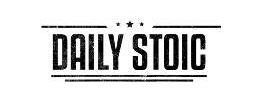 The Daily Stoic is a website that sends out useful emails and advice based on stoicism a few times a week. I’ve been getting their mailouts since the end of last year and they always offer insightful food for thought around how to live with greater tranquility. There is also a companion book (also called The Daily Stoic), which I haven’t read yet but follows a similar principle of one lesson per day.
The Daily Stoic is a website that sends out useful emails and advice based on stoicism a few times a week. I’ve been getting their mailouts since the end of last year and they always offer insightful food for thought around how to live with greater tranquility. There is also a companion book (also called The Daily Stoic), which I haven’t read yet but follows a similar principle of one lesson per day.
In case you missed it…
#107: Just One Thing {podcast}
Support Becoming Who You Are on Patreon for Special Perks and Rewards
How to Cultivate Ninja Active Listening Skills
4 Common Myths About Vulnerability (and the Truth Behind Them)
Quieting Our Minds When Life Becomes Challenging
20 Lists to Make When You Need a Quick Pick-Me-Up
Have a great March!
Image: Sticker Mule
The post Goodbye February appeared first on Becoming Who You Are.









February 26, 2017
20 Lists to Make When You Need a Quick Pick-Me-Up
Today, I want to share a version of one of my favourite journaling exercises: lists.
After my daughter was born, I experienced a couple of episodes of “the baby blues:” a few days of feeling pessimistic, listless and tearful (N.B. this isn’t the same as postnatal depression, which lasts for longer, tends to be more severe and is best supported by professional attention). Each time, I knew that nothing was wrong per se. In fact, I was—and am—loving motherhood. The way I felt was mostly due to a combination of tiredness, hormonal changes, and the fact I was (and again am) still finding the balance between caring for my daughter and meeting my own needs. I knew it would pass but, in the meantime, I decided to do what I could do to improve my mood.
Something I found helpful was a simple journaling technique I share in The Ultimate Guide to Journaling: lists. Lists are among my favourite journaling techniques because they are quick but powerful exercise for getting clarity, exploring ideas and having fun. To start with, I got meta and created a list of lists to make when I needed a quick pick-me-up. Then, the next time I needed a quick mood boost, I’d pick one and spend a few minutes writing out as many responses as I could think of. Taking just 10 minutes to do this when I was feeling down helped me get out of a negative feelings -> negative thoughts -> negative feelings pattern and left me feeling refreshed and more like myself again.
I know we all have blah days, so I’m sharing my meta list in case it’s useful for you too. None of these lists are particularly profound, but they are a helpful reminder of the positive and potential in our lives during times when we might lose sight of those things:
20 lists to make when you need a quick pick-me-up
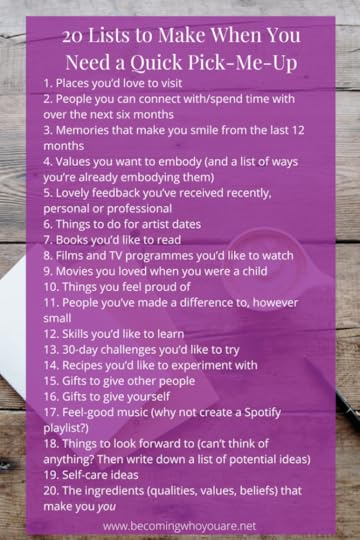
A list of places you’d love to visit
A list of people you can connect with/spend time with over the next six months
A list of memories that make you smile from the last 12 months
A list of values you want to embody (and a list of ways you’re already embodying them)
A list of lovely feedback you’ve received recently, personal or professional
A list of things to do for artist dates
A list of books you’d like to read
A list of films and TV programmes you’d like to watch
A list of movies you loved when you were a child
A list of things you feel proud of
A list of people you’ve made a difference to, however small
A list of skills you’d like to learn
A list of 30-day challenges you’d like to try
A list of recipes you’d like to experiment with
A list of gifts to give other people
A list of gifts to give yourself
A list of feel-good music (why not create a Spotify playlist?)
A list of things to look forward to (can’t think of anything? Then write down a list of potential ideas)
A list of self-care ideas
A list of the ingredients (qualities, values, beliefs) that make you you
What feel-good lists would you add to this list? Leave a comment and share your thoughts!
 If you enjoyed this post and would like to support Becoming Who You Are, check out our Patreon page. Patreon is a simple way for you to contribute to this site and support the free content, tools and resources here. As a thank you for your support, you can get special Patron-only perks and rewards; find out more here.
If you enjoyed this post and would like to support Becoming Who You Are, check out our Patreon page. Patreon is a simple way for you to contribute to this site and support the free content, tools and resources here. As a thank you for your support, you can get special Patron-only perks and rewards; find out more here.
The post 20 Lists to Make When You Need a Quick Pick-Me-Up appeared first on Becoming Who You Are.









February 19, 2017
4 Common Myths About Vulnerability (and the Truth Behind Them)
Like authenticity, vulnerability is a buzzword right now. Since Brené Brown released her now-famous TED talk on shame and vulnerability, it’s become an en vogue personal growth topic. While it’s great more and more people are talking about vulnerability, there are also a lot of myths about vulnerability and misconceptions about what it really means (beyond “vulnerability = weakness”—if you’re here reading this, I’m assuming you know that’s not the case!). Today, I want to share a few of the most common myths about vulnerability I’ve heard over the last couple of years and unpack the truth behind them:
1. Vulnerability is radical honesty
Like authenticity, one of the most common myths about vulnerability is that it’s the same as “sharing everything.”
One of the not-cool ways this plays out is when someone lets loose with personal attacks and judgements under the guise of “being vulnerable.” Vulnerability isn’t a justification for disrespectful communication, nor is it a mask for anger (in reality, it’s usually the other way around).
Vulnerability also isn’t about sharing our deepest, darkest secrets with people who haven’t yet earned the right to hear them. That’s not vulnerability, it’s not having boundaries. Not only is this a lot of pressure to put on a new or fledgeling relationship, but it leaves us open to people mishandling our disclosures and greeting them with a less-than-kind response. As Brené Brown points out many times in her work, vulnerability is earned. There are things that have happened in my life that only a handful of people know about. This isn’t because I’m ashamed of them or feel like I need to hide them, but because they’re personal and few people have earned that kind of trust and intimacy. I’ve learned the hard way that not everyone is a good candidate for vulnerability.
So how do we stay on the side of vulnerability without sliding into radical honesty? First of all, empathy. Thinking about how what we say might land with the other person. Being self-aware (and self-honest) enough to acknowledge—at least to ourselves—when there might be one or more other emotions underlying our desire to let loose and owning those feelings, however uncomfortable they might be. Perhaps this looks like saying “I’m feeling hurt” if that’s what we’re feeling or “I would like to ask for reassurance” if that’s what we want. It involves recognising our own shadow side and choosing connection over validation rather than becoming mired in self-righteousness.
When it comes to sharing the things that shape us the most, we can start with that question: has this person earned the right to hear this? Other questions I find useful to ask myself are: what is my intention for sharing this? What need am I trying to meet here? When I think about the times I’ve felt a sense of urgency to share something personal within a relationship that doesn’t have the foundation or context for it, I’ve noticed there is usually another motivation underlying this; perhaps a desire to be seen or to create a shortcut to intimacy (which is what we’ll address next.) That sense of urgency is my warning signal to acknowledge these desires, to accept them—which usually causes them to lessen in intensity—and to find other ways to meet my needs that also enable me to honour my boundaries.
2. Vulnerability is a short-cut to intimacy
Vulnerability is a building block in trusting relationships and it’s necessary for those relationships to form, but it’s not a short-cut to intimacy.
When we come into an interaction expecting being vulnerable will result in us leaving with a new BFF, we set ourselves up for disappointment and frustration. Sometimes, I feel it would be lovely if I could simply expedite certain friendships before they have ripened. The very act of becoming friends with someone is in itself a vulnerable thing. But true intimacy is created brick by brick. If we try to put the roof on before the foundations and walls are in place, it’s going to come crashing down pretty quickly.
When it comes to relationships, I’ve found that the vulnerability that counts is the kind that comes with zero strings attached. True intimacy-building vulnerability isn’t a single flash in the pan, it’s showing up consistently for the other person and being willing to be present, engaged and authentic time after time. To me, this looks like being willing to go back in, even if our bids for connection weren’t met the first time around. It looks like practising patience and finding joy in the “getting to know you” stage, exploring the other person’s world and sharing mine, brick by brick.
3. Everyone should be vulnerable at all times
Vulnerability isn’t an entitlement, nor is it something we automatically owe to people. I’m not particularly vulnerable around people I don’t know or whom I don’t trust. We get to decide when and around whom we’re vulnerable. Like compassion, it’s a gift.
Different degrees of vulnerability are appropriate in different situations. Vulnerability can also look like different things depending on the context. I recently talked with a client who was upset because she had shared something personal with an office colleague and hadn’t had the reception she’d hoped for. While I could see she was trying to meet a need for visibility and connection, I also questioned: was work the best place to get that? Or was there another setting where she would be more likely to meet these needs through sharing and connection?
Like all matters relating to vulnerability and boundaries, where these degrees lie for us is a personal decision. What feels comfortable for you? Which situations do you feel warrant a greater level of vulnerability and which less? Where does your intuition say the line falls in each situation?
4. Vulnerability is one size fits all
As we’ve already looked at, vulnerability looks like different things to different people in different contexts. Vulnerability with my husband or a close friend might look very different to the vulnerability that comes with hearing a coaching client talk about a deep struggle any being willing to sit with any discomfort that might provoke for me. Both those situations require vulnerability, but they are very different contexts.
Equally, different people have different thresholds for vulnerability that are defined by our experiences and beliefs. For one person, vulnerability might look like getting up on a stage to share a personal story in front of 1000 people. For someone else, it might look like showing up to their first dance class, unsure of what to expect.
Our personal brand of vulnerability is ours alone, and our responsibility to ourselves is to figure out what vulnerability looks like to us through self-exploration, experimentation and trial and error (yes, even the process of figuring out our relationship with vulnerability is a vulnerable quest). However, if we’re coming from a place of self-awareness around our intentions and expectations, there is no “wrong” way to show up and live it.
Which myths about vulnerability do you hear most often? And what do you know to be true? Leave a comment and share your thoughts.
Further reading: Brené Brown, vulnerability and daring greatly & Getting real in relationships with Dr. Susan Campbell
 If you enjoyed this post and would like to support Becoming Who You Are, check out our Patreon page. Patreon is a simple way for you to contribute to this site and support the free content, tools and resources here. As a thank you for your support, you can get special Patron-only perks and rewards; find out more here.
If you enjoyed this post and would like to support Becoming Who You Are, check out our Patreon page. Patreon is a simple way for you to contribute to this site and support the free content, tools and resources here. As a thank you for your support, you can get special Patron-only perks and rewards; find out more here.
The post 4 Common Myths About Vulnerability (and the Truth Behind Them) appeared first on Becoming Who You Are.









February 12, 2017
Quieting Our Minds When Life Becomes Challenging
This is a guest post by Antonia Lyons.
I have been quiet for a couple of weeks, mainly due to a mysterious illness while away on vacation in Italy which forced me to stop and reconsider a couple of things in my life.
While this would have normally thrown me into a state, I instead found myself watching my week evolving as if I were enjoying a play at the theatre.
I sensed freedom in my ability to witness the events that came up during my holiday with some sort of detachment. Nothing was going to change; I was stuck in a bed and needed to be so because my body was obviously exhausted.
So I took this time to pause and re-think the direction my life had recently taken.
I had to admit that I got trapped in an unhealthy pattern of wanting to control life as much as I can.
Isn’t it funny how even those in my field will from time to time succumb to the attempts of their mind to try and manipulate reality so to make it ok?
I thought I knew better, and I obviously didn’t.
But strangely enough I didn’t see this to be problem. While I’d normally panic, this time I just shrugged and thought “Oh dear, here we go again, I’ve been trying to manipulate life!”
Trouble is we all do that, to an extent.
We all try to manipulate circumstances to feel good.
It’s what our mind does, it’s its job. It doesn’t really do it well, but it’s what our mind is programmed to do. Our mind is programmed to take us back to a state of balance whenever life gets challenging, but it does so based on data that it’s been storing since our birth.
So while we try and control things outside of us based on whatever our mind is telling us, we drive ourselves to exhaustion because not only we will never be able to control life from happening but we will also react to our feelings about what’s happening.
Pretty messy, huh?
So if me getting ill while on holiday may look like the worst of luck, it was actually a very good thing.
It gave me the chance to realise that no matter my studies and my job, I still believe my mind. I believe it so much in fact, that I’m always doing what it says even when it’s apparent it’s all lies.
So here I am, on my way back to health, knowing I had this a long time coming.
This is my time to really ask myself the question I have been dreading “am I or am I not going to let my mind run my life?”
Because I could spend hours meditating my life away or throw myself in all sorts of techniques to keep my mind at bay, but I know only too well that it will never ever work.
Until I make the decision in my heart that I can truly be ok with whatever my mind wants to think and that I am not my mind, I will spend my life trying to control a game I cannot control. Life will always happen, the sun will always come up and go down, people will be born and will die, one moment I’ll feel happy and next I’ll be in tears: all of this will happen regardless of what I do or think.
This is the game of life, and I’m here, same as everybody else, playing it the best I can.





